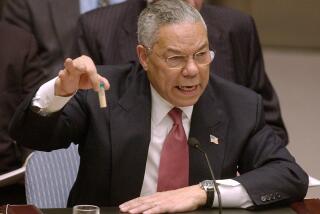Blair words on Iraq changed after 2002 visit with Bush, Briton testifies
- Share via
Reporting from London — A meeting between President George W. Bush and British Prime Minister Tony Blair a year before the 2003 invasion of Iraq marked a turning point in the march toward war, Britain’s former ambassador to the United States testified Thursday.
Giving evidence on the third day of an independent British inquiry into the war, Christopher Meyer told the five-member investigating panel that Blair’s stance on Iraqi President Saddam Hussein appeared to shift after the prime minister met with Bush at his Texas ranch in April 2002.
“I’m not entirely clear what degree of convergence was signed in blood at the Crawford ranch,” said Meyer, who served as Blair’s ambassador to Washington from 1997 to 2003.
But he interpreted Blair’s hard talk on Iraq in a speech days after the meeting as “a tightening of the U.K.-U.S. alliance and a degree of convergence on the danger that Saddam Hussein presented.”
Referring to Iraq and the need for the West to act on Hussein’s resistance to international pressure, he said, Blair used the term “regime change” for the first time.
In the speech, the Labor prime minister said, “If necessary, the action should be military and again, if necessary and justified, it should involve regime change.”
By early 2002, Britain’s preferred policy of “containment” with regard to Hussein seemed to be failing, he testified.
Asked by a committee member if it was considered a “dead duck” by then, Meyer replied: “Was war inevitable, you mean? What was inevitable was that Americans were going to bust a gut to carry out the mandated policy of regime change.”
U.S. policy toward Iraq had hardened, he said, after anthrax-contaminated mail killed five people in 2001 right after the Sept. 11 attacks.
“Anthrax letters . . . really spooked people,” Meyer said. “And the last person they knew who had used it was Saddam Hussein.”
Although there was no proof of Al Qaeda involvement in the attacks, several senior members of the Bush administration remained convinced of the terrorist network’s involvement, Meyer explained, saying he knew the U.S. was trying to find a connection to Hussein.
Bush submitted to the advice of his national security advisor “with a chorus of Europeans and an Australian, of whom Tony Blair was the most significant,” to go “down the U.N. path,” Meyer said.
But the U.S. leader went “against the wishes of his vice president, very vociferously expressed.”
Bush “in his heart . . . just wanted to get over there and kick Saddam out. In his head . . . he realized he couldn’t just do that,” Meyer said.
But “the U.S. military timetable was already in place before weapons inspectors went in,” Meyer asserted, and looking at the timetable of weapons inspections, “it was impossible to see how [former U.N. weapons inspector Hans] Blix could bring the inspection process to a conclusion by March [2003].”
“U.N. Resolution 1441 was a challenge to Saddam Hussein to prove his innocence,” Meyer continued, “but . . . somehow you had to short-circuit the inspection process by finding the notorious smoking gun, and . . . because of the unforgiving process of the military timetable, we found ourselves scrabbling for the smoking gun. . . .”
“It was another way of saying, ‘It’s not that Saddam Hussein has to prove he’s innocent, we’ve now got to bloody well prove he’s guilty.’ And we -- Americans and British -- have never really recovered from that because of course there was no smoking gun.”
After all the witnesses have been heard by early next year, the panel is to issue a final report, probably in late 2010 or early the following year.
Stobart is a news assistant in The Times’ London Bureau.
More to Read
Sign up for Essential California
The most important California stories and recommendations in your inbox every morning.
You may occasionally receive promotional content from the Los Angeles Times.








